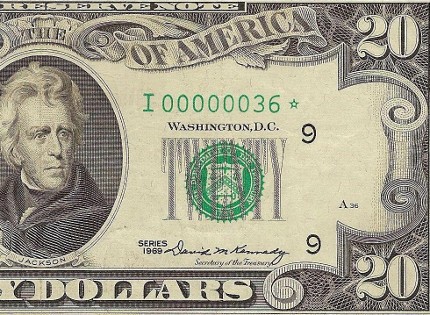


The obverse of the note featured a portrait of General Winfield Scott. These notes were not primarily designed to circulate and were payable to the original purchaser of the dollar bill. 1861: Three-year 100-dollar Interest Bearing Notes were issued that paid 7.3% interest per year.2 Removal of large denomination bills ($500 and up).Possible reasons included economic instability that affected other currencies, and use of the bills for criminal activities. However, a 2018 research paper by the Federal Reserve Bank of Chicago estimated that 80 percent of $100 bills were in other countries. Federal Reserve data from 2017 showed that the number of $100 bills exceeded the number of $1 bills. The new bill costs 12.6 cents to produce and has a blue ribbon woven into the center of the currency with "100" and Liberty Bells, alternating, that appear when the bill is tilted.Īs of June 30, 2012, the $100 bill comprised 77% of all US currency in circulation.
#1990 20 dollar bill serial number lookup series
The Series 2009 $100 bill redesign was unveiled on April 21, 2010, and was issued to the public on October 8, 2013.

It has been suggested this may refer to 4/10, or April 10, the 100th day of the year. Bureau of Engraving and Printing, showed approximately 4:10. The time on the clock of Independence Hall on the reverse, according to the U.S. It is also the only denomination today to feature a building not located in Washington, D.C., that being Independence Hall located in Philadelphia on the reverse. The bill is one of two denominations printed today that does not feature a president of the United States the other is the $10 bill, featuring Alexander Hamilton. The bills are also commonly referred to as "Bens", "Benjamins", or "Franklins", in reference to the use of Benjamin Franklin's portrait on the denomination, as "C-Notes", based on the Roman numeral for 100, or as "blue faces", based on the blue tint of Benjamin Franklin's face in the bill's current design. As of December 2018, the average life of a $100 bill in circulation is 22.9 years before it is replaced due to wear. The $100 bill is the largest denomination that has been printed and circulated since July 13, 1969, when the denominations of $500, $1,000, $5,000, and $10,000 were retired. On the reverse of the banknote is an image of Independence Hall in Philadelphia, which has been used since 1928. Statesman, inventor, diplomat, and American founding father Benjamin Franklin has been featured on the obverse of the bill since 1914. The first United States Note with this value was issued in 1862 and the Federal Reserve Note version was launched in 1914, alongside other denominations. The United States one-hundred-dollar bill ($100) is a denomination of United States currency. Security fibers, watermark, 3D security ribbon, security thread, color shifting ink, microprinting, raised printing, EURion constellationīenjamin Franklin, Declaration of Independence, quill pen, inkwell with an image of the Liberty Bell Current denomination of United States currency One hundred dollars (United States)


 0 kommentar(er)
0 kommentar(er)
